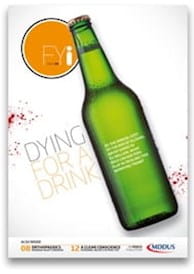INCREASING numbers of doctors and medical students are using smartphones and associated “apps” in clinical practice. A recent survey conducted by the General Medical Council found that currently 30 per cent of doctors use a smartphone for medical apps. A number of studies predict this will rise to 90 per cent this year.
There are many different kinds of medical apps, and up to now most have been informative only. However, increasingly medical apps are being developed and marketed that operate in conjunction with a medical device. For example, medical apps are available to analyse an electrocardiogram, interpret an arterial blood gas analysis and there are even apps that can be used to perform an ultrasound or measure blood glucose and share the results with the health professional. Other medical apps make it possible to interpret and access imaging studies on the smartphone at the point of care.
These new medical apps have great potential for improving our practice by providing a quick, comprehensive and up-to-date overview of current clinical guidelines, which could aid decision-making and change the way healthcare is delivered by the next generation of doctors. Apps that are used in clinical care, or apps that can be classified as a medical device, have to meet certain standards and rules but if something goes wrong, the doctor could be held responsible.
The potential of medical apps has not gone unnoticed by developers – more than 17,000 are now available for several platforms. But how can you sift the good from the bad? Their sheer number makes it difficult for healthcare professionals to locate reliable apps. How can you know if an app is reliable, evidence-based or developed without a conflict of interest?
Some recent studies have addressed the lack of evidence and professional medical involvement in the design and development of medical apps. This raises concerns over the reliability and accuracy of the medical content and the potential consequences for patient safety. Certainly, many apps in the medical sector suffer from being totally trivial and useless to downright dangerous. The use of medical apps in clinical practice can pose several potential risks to patient care due to the unique characteristics of the medium, the potential breach of patient confidentiality, conflicts of interests and erroneous clinical decision-making.*
To date, there is no regulation governing the use of medical apps in the UK. In the US, the Food and Drug Administration released draft guidelines on medical apps in 2011. The FDA plans to regulate apps that work as accessories to FDA-regulated devices or that turn smartphones into medical devices to monitor conditions such as abnormal heart rhythms. It has been proposed that medical apps should be peer- reviewed by clinical experts and that regulatory measures should be increased in order to safeguard quality of care.
Websites have been launched (such as iMedicalApps - www.imedicalapps.com) to index, provide commentary and review medical applications. However, the review criteria do not address scientific evidence for medical content, but solely concern matters of usability, design and content control. On the other hand, no better alternative exists and for the time being they can provide valuable reviews. Because of this lack of proper quality indicators, some companies are creating their own medical app market and “app certification programs” (for example, Happtique— www.happtique.com) However, app markets regulated by commercial concerns could have conflicts of interest about which apps get published.
Medical app development is one of the most dynamic fields in medicine with big potential to change how healthcare is delivered in the future. It can be difficult to decide which app to buy and use. A few key questions (see below) can help you critically appraise medical apps rather than simply taking them at face value.
Dr Benjamin J. Visser is a trainee in the intensive/critical care unit at the Onze Lieve Vrouwe Gasthuis in Amsterdam
*Further reading: Visser BJ, Bouman J. There’s a medical app for that. Student BMJ 2012;20e2162
Questions to ask before downloading an app
Patient confidentiality
• Does the app require you to input patient specific data and could this compromise patient confidentiality?
Clinical decision-making
• Is the primary purpose of the app to inform (or to be used by) a health professional (and not patients)?
• Is the app a medical device? If so, is the medical app certified by a regulating body?
• Is it produced by a medical publisher or medical accrediting organisation? For example, apps adopted by a medical journal or patient association.
• Is the app regularly updated? Is it properly referenced? Is it possible to give feedback?
• Are the authors listed? Are contributions to the app transparent? Is there medical professional involvement in their development?
• Is the (medical) content peer-reviewed? Did you read reviews by peers? For example on www.imedicalapps.com;
• Has it been recommended by your tutor, university or healthcare institution?
Conflict of interests
• Do you know where the app is from? Is it produced by a commercial party (pharmaceutical industry) or a non-commercial organisation?
This page was correct at the time of publication. Any guidance is intended as general guidance for members only. If you are a member and need specific advice relating to your own circumstances, please contact one of our advisers.
Read more from this issue of FYi

Save this article
Save this article to a list of favourite articles which members can access in their account.
Save to library
